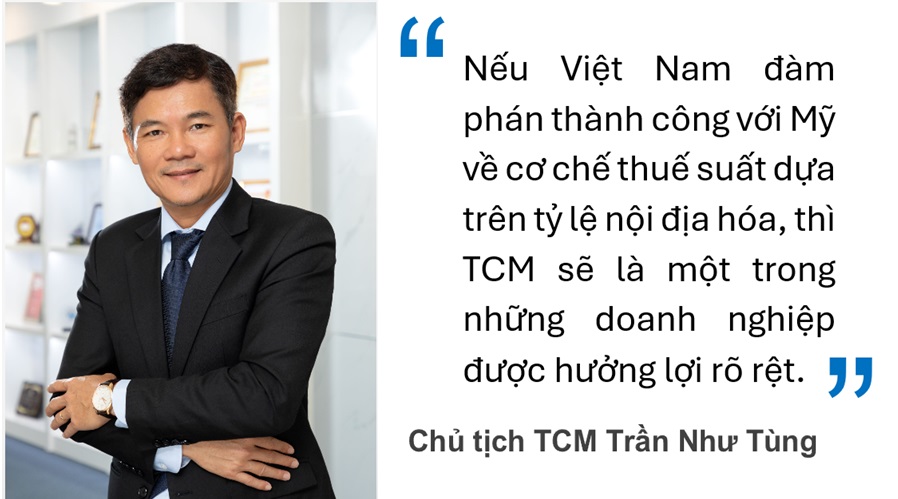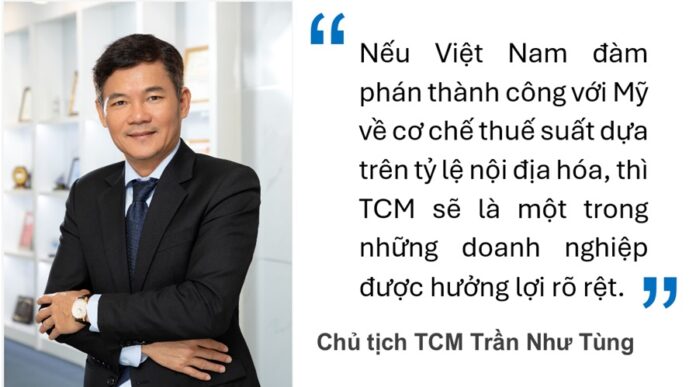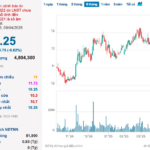At the 2025 AGM of TCM, Chairman Trần Như Tùng took time to address a topic of particular interest to shareholders: the impact of US tariffs on the Vietnamese textile industry and TCM‘s advantages in overcoming this tariff barrier.
Position of Vietnamese Textiles on the US Export Map
According to the Chairman, in 2024, the Vietnamese textile industry achieved an export turnover of approximately 44 billion USD. The plan for 2025 is to export 48 billion USD, equivalent to an increase of about 10%. This figure was established in December 2024, before April 2, 2025 – a landmark in the change of US trade policy. However, this plan has not been adjusted yet as Vietnam lacks clear information on the specific impacts of the new policies.
Considering the type of business, FDI enterprises continue to account for a large proportion of textile exports. While in the period before 2023, the export ratio of this group was maintained at 58-59%, in 2024 it increased to 62%. This is also one of the reasons why President Donald Trump mentioned the connection in the textile supply chain between China, Vietnam, and the US market.
On a global scale, China remains the world’s largest textile exporter with a turnover of 314 billion USD, followed by the group of 27 EU countries (218 billion USD), Bangladesh (45 billion USD), and Vietnam (44-45 billion USD). Although Bangladesh’s export turnover is almost equal to that of Vietnam, it is not yet a significant competitor to Vietnam in this industry.
The US is also the largest export market for the Vietnamese textile industry, accounting for nearly 40% of total export turnover; followed by Japan, Europe, South Korea, and China.
The proportion of US textile imports peaked in 2022, along with a strong recovery of the Vietnamese textile industry in the first half of that year. However, due to the large volume of imports, the US faced high inventory levels in 2023. It wasn’t until the end of 2023 that the inventory was cleared, causing imports to inch up again in the first quarter of 2024.
In 2024, the US imported a total of about 407 billion USD of textiles, with garments accounting for 40% to over 50%. The total volume of imports into the US reached about 12.5 million tons, with an average unit price of 7.8 million USD/kg, indicating that it is a very large import market for the global textile industry. Currently, more than 98% of the clothing sold in US malls is also imported.
However, a major turning point occurred after April 2, 2025, when President Donald Trump officially imposed tariffs on imports from many countries. Among them, Cambodia, despite its small export ratio, was subjected to the highest tax rate, followed by Vietnam and then China.
Recently, just a few days ago, the US imposed a tax rate of up to 245% on some Chinese goods – a rate that has almost frozen trade between the US and China.
Vietnam is the second-largest exporter of garments to the US, after China. However, the average unit price of Vietnamese garments exported to the US has continuously decreased, from 3.8 USD/m2 in 2022 to 3.26 USD/m2 in 2024. Meanwhile, production costs have increased, but selling prices have remained unchanged, putting significant pressure on textile businesses.
Vietnamese Textiles Caught Between US-China Trade Relations
To achieve the textile export turnover of 44 billion USD, Vietnam also had to import 24.8 billion USD of input materials such as fabric, yarn, and cotton – with fabric accounting for the largest proportion. Notably, 50-60% of this fabric is imported from China, indicating a high dependence on raw material sources from this country.
At the same time, the US is the largest export market for the Vietnamese textile industry. This puts Vietnam in a difficult position, as without China, Vietnamese businesses would struggle to secure sufficient input materials at appropriate costs and qualities; but without the US as an export destination, export activities would also face challenges. Clearly, both China and the US are important links in Vietnam’s textile supply chain.
With the tax rate imposed by the US, the possibility of Chinese goods entering the US market is almost blocked. This opens up a great opportunity for Vietnam. The “dozen billion USD” pie of the textile industry that used to belong to China must now shift to other countries, and Vietnam is a potential destination.
If the US imposes high taxes on all countries, Vietnam is not too concerned because “if everyone is high, then we are high together.” The biggest concern is that Vietnam will be at a competitive disadvantage if it faces higher taxes while other countries have lower rates.
“Moreover, even if US consumers tighten their spending due to high tariffs affecting textile prices, the demand is still significant. They can’t stop wearing clothes. If they used to buy 12 sets/year, they might reduce it to 5-8 sets, but it’s still a considerable market,” said the leader of TCM.
However, to seize this opportunity, Vietnamese businesses need to be well-prepared in terms of raw material traceability, an element that US customs controls very tightly. Raw materials from China will be subject to different taxes, and if they are from Vietnam or third countries, they will be taxed at a lower rate.

TCM’s Unique Advantages in Overcoming Tariff Barriers
Compared to many other domestic enterprises, TCM has a closed-loop model from yarn and fabric to garment manufacturing, giving the company more autonomy over raw materials. Notably, TCM mainly imports cotton and accounts for a small proportion of spun yarn production, with the rest being domestically produced. Meanwhile, most other Vietnamese textile enterprises still depend on imported fabric, mainly from China.
Currently, the US is tightening controls on goods labeled “Made in Vietnam” but using raw materials from China. Vietnam’s Ministry of Industry and Trade has also taken steps to require tighter control over the volume of raw materials imported from China, especially in the textile industry.
If Vietnam successfully negotiates with the US on a tax rate mechanism based on the domestic localization ratio, TCM will be one of the most benefited enterprises. The reason is that when high taxes are imposed on raw materials from China, the demand for purchasing fabric from Vietnam will increase, and TCM is a company that sells fabric.
Another important advantage for Vietnam is that it has signed 16 free trade agreements, notably the EVFTA and CPTPP. Since 2025, most exports to the EU will enjoy a tax rate of 0%. However, EVFTA requires origin from raw materials onwards, meaning that enterprises must buy fabric in the country if they want to take advantage of tax incentives, once again emphasizing TCM‘s advantage in domestic fabric supply.
In fact, in recent days, international customers have started to look for suppliers in Vietnam instead of China due to concerns about the prolonged US-China trade war. This is a positive signal for Vietnam in general and TCM in particular. However, TCM may also face new pressures as Chinese factories may shift their exports to other markets such as Japan and South Korea, where TCM currently has a large export share. Therefore, while expanding its market share in Europe, TCM needs to be ready to compete in its traditional markets.
“We cannot continue to compete with simple or cheap products because countries that come after us, like Bangladesh, have much lower labor costs and advantages in that segment. Therefore, TCM’s strategy is to focus on developing products with higher added value, along with expanding our customer base and enhancing cost control and sustainable development.
In the long term, TCM aims to become the first domestic textile enterprise to apply artificial intelligence (AI) in management and production operations. After completing the digital transformation, we have accumulated a large volume of data that is standardized and of high quality – this is an important foundation for integrating AI into the value chain.
By implementing AI, we expect to solve many problems in governance and customer experience. For example, customers can access the system and know exactly how long it will take to deliver an order of 100,000 products – without having to send emails, make phone calls, or communicate multiple times with the sales department. Everything will be automated, transparent, and fast. To achieve this, we need a robust ERP system that comprehensively synchronizes data from production, sales to logistics. We aim to complete the digital transformation project by 2025,” emphasized Mr. Tung.
– 07:22 21/04/2025
The Billionaire’s Daughter: A $41 Million Rescue Mission for Her Father’s Struggling Empire
“With an astute eye for investment, Ms. Hoang Anh has just made a significant move in the stock market. She has purchased an impressive 4 million HAG shares, a bold decision that has caught the attention of the financial world.”
“Donald Trump’s Election Victory: Currency Manipulation and Exchange Rates”
In the recent US presidential election, Donald Trump’s victory was not just a win, but a Republican sweep of both houses of Congress. This outcome has profound implications, not just for the United States but for the entire world. Among the many consequences is the impact on exchange rates, particularly for countries with significant trade surpluses with the US, and Vietnam presents a rather unique case in this regard.



















